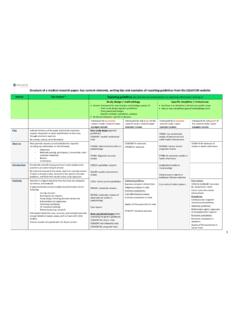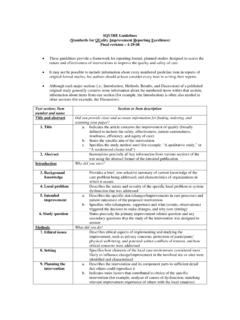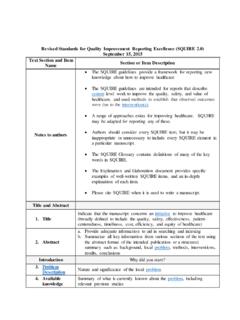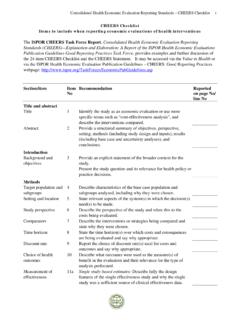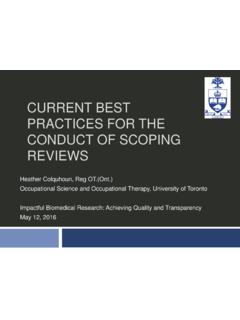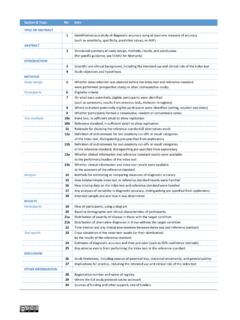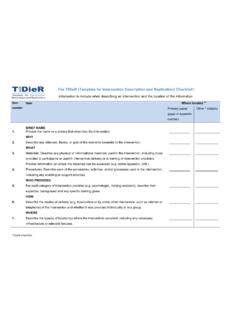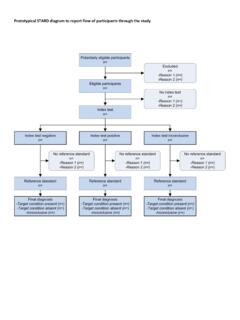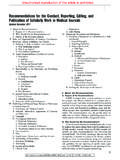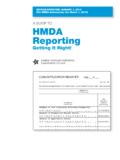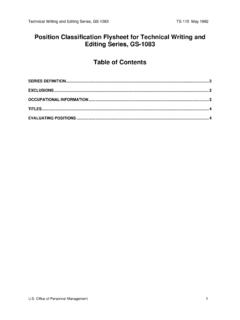Transcription of Guidelines for reporting health research - …
1 Guidelines for reporting health research : How to promote their use in your journal Written by the EQUATOR Network Group; updated August 2013. Key points: reporting Guidelines help to improve the accuracy, transparency and completeness of health research publications and increase the value of published research EQUATOR provides free online resources in English at and in Spanish at including a comprehensive collection of reporting Guidelines for health research studies EQUATOR recommends that editors: explore the available reporting Guidelines ; select well developed Guidelines appropriate for the reporting of research studies published by their journal; ask authors to adhere to these Guidelines and ask peer reviewers to use them when assessing manuscripts In this document you will find information on: How your journal can support better reporting of health research How to introduce reporting Guidelines into your journal How to select reporting Guidelines for your journal How and where to use reporting Guidelines in a journal How to refer to the EQUATOR Network and reporting Guidelines in your Instructions to Authors and Instructions for Peer Reviewers How to describe the EQUATOR Network; text that might be inserted into your Instructions to Authors; examples of how some journals encourage the use of reporting Guidelines and refer to EQUATOR.
2 Introduction Although the ultimate responsibility for the design, conduct and accurate publication of research studies lies with the researchers, editors should take all reasonable steps to ensure the quality of the material they publish (1). Guidelines for reporting health research are important tools to facilitate this task. They specify a minimum set of items needed for a complete and clear account of study methods and subsequent findings. Adherence to reporting Guidelines improves the accuracy and transparency of publications (2-5). Examples of the most frequently used reporting Guidelines include: CONSORT Statement for reporting randomised controlled trials (RCTs) (6). PRISMA Statement for reporting systematic reviews and meta-analyses evaluating health care interventions (7). STARD Statement for reporting diagnostic accuracy studies (8).
3 STROBE Statement for reporting observational studies in epidemiology (9). As part of their endorsement strategy, many journals publishing health research refer to such reporting Guidelines in their Instructions to Authors and some require authors to adhere to them ( BMJ, PLoS Medicine, BJOG, Annals of Emergency Medicine). Recent surveys of Instructions to Authors (10,11) noted that the uptake of reporting Guidelines by journals is still inadequate although there has been some improvement over time (10). Use of ambiguous language on how to use relevant Guidelines was also highlighted as a particular problem. Recent years have seen a proliferation of new reporting Guidelines motivated mainly by the insufficient quality of published reports. However, there are important differences in the scope, format, and development methodologies of those Guidelines (12).
4 This creates a rather confusing situation for editors who need to know which Guidelines exist and decide which to support and recommend to authors to follow. 1. The EQUATOR Network is an international initiative that works towards improving this situation. The EQUATOR team collates resources facilitating the reporting of health research , provides education about the available Guidelines , and supports the development of new reporting Guidelines . The EQUATOR website ( ) aims to be a valuable source of information for authors, journal editors, peer reviewers, and guideline developers. The site currently provides links to over 200 reporting Guidelines and a major upgrade is in process that will enhance the site with fully searchable database of reporting Guidelines , more background information about the Guidelines , and new educational materials.
5 The online resources were also translated into Spanish ( ) as part of the collaboration between EQUATOR and Pan American health Organization aimed at raising standards of research reporting in American regions. How your journal can support better reporting of health research Here we provide some suggestions on how to bring into your organisations the knowledge of good research reporting practice acquired from the EQUATOR website and workshops. A. How to introduce reporting Guidelines into your journal Well developed reporting Guidelines provide helpful guidance on how to report research studies transparently and without omitting key information. Their efficient use represents knowledge vital for journals striving for excellence in health research publishing and can give a journal an important competitive advantage.
6 To ensure the best use of this knowledge it needs to be managed effectively within journals. In order to maximise the benefits of information and workshops provided by EQUATOR you might consider some of the following actions in your own journal: 1. Incorporate an explicit philosophy of transparent and accurate reporting and the use of reporting Guidelines into your publishing strategy 2. Assess how (and if at all) are reporting Guidelines used in your journal 3. Think about the best ways to include reporting Guidelines in your working practices, pilot and introduce best practice'. 4. Consider how to maintain sufficient knowledge of principles of good reporting ' and reporting Guidelines ( through training or dedicating a member of staff as an expert/mentor). B. How to select reporting Guidelines for your journal There is a growing number of reporting Guidelines , but they were not all created with the same rigour.
7 When considering endorsing a reporting guideline for your journal consider its relevance to the articles you publish, and also seek affirmative answers to the following five questions: 1. Is the guideline development process sufficiently transparent, so that it could be repeated by interested readers? 2. Did the guideline development involve systematic searching for and consideration of all the available evidence relating to the guideline recommendations? 3. Was any consensus process used as part of the guideline development? 4. Has the guideline been evaluated or is there a plan to do so (does it have its intended effect)? The EQUATOR Network has published methodological guidance for developers of reporting Guidelines (13), initiated work on investigation of barriers and facilitators to implementing reporting Guidelines within journals, and started developing a tool for the critical appraisal of available reporting Guidelines .
8 The results of these projects should facilitate the process of identifying which Guidelines are suitable to be supported by a journal. C. How and where to use reporting Guidelines in a journal reporting Guidelines complement journals' Instructions to Authors so journals should take advantage of their existence. Here are a few suggestions of what you can do in your journal: Refer to the EQUATOR Network website in your Instructions to Authors'. o This has the advantage of ensuring that readers will have access to up-to-date versions of available reporting Guidelines 2. Alert authors to selected reporting Guidelines and motivate their use: o Clearly describe the purpose of reporting Guidelines they are to help authors to include all important information about their research , which can increase the probability of their manuscript being published and enhance the value of their research to clinicians and other researchers o Link to the appropriate Guidelines , through the EQUATOR or guideline website, as these provide the current version, and make checklists available to download o Provide clear instructions how you expect authors to use appropriate Guidelines , including a clear statement of the degree of compliance with relevant Guidelines that is expected.
9 Ambiguous instructions won't encourage adherence Consider how best to remind your authors about reporting Guidelines in your manuscript submission software Alert your peer reviewers to the importance of good reporting and ask them to use selected Guidelines /. checklists during their manuscript assessment Share your knowledge about reporting Guidelines and EQUATOR Network with your editorial colleagues, and consider subscribing to the EQUATOR Newsletter alerting you to new developments in health research reporting and available education and training courses Consider writing an editorial supporting transparent research reporting and the use of selected reporting Guidelines in your journal How to refer to the EQUATOR Network and reporting Guidelines in your Instructions to Authors'. We do not think there is a correct' way to inform readers about the EQUATOR Network.
10 Perhaps a useful start is to include a brief description of the Network with a focus on the reporting Guidelines resource centre for authors and give reasons why authors should adhere to the recommended Guidelines . For example, the following text can be used to describe the EQUATOR Network: The EQUATOR Network is an international initiative that seeks to improve the reliability and value of published health research by promoting transparent, accurate and complete reporting . The EQUATOR website provides a central repository of up-to-date reporting Guidelines and other resources assisting in a preparation of good research manuscript (English: ; Spanish: ).'. Here is an example of text that might be inserted into your Instructions / Resources for Authors: Responsible reporting of research studies, which includes a complete, transparent, accurate and timely account of what was done and what was found during a research study, is an integral part of good research and publication practice and not an optional extra.
